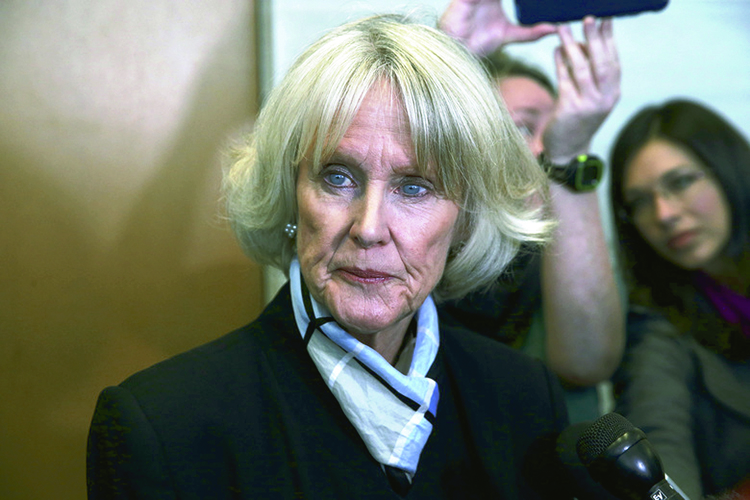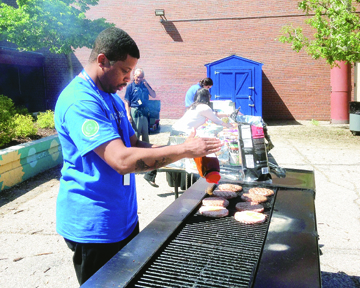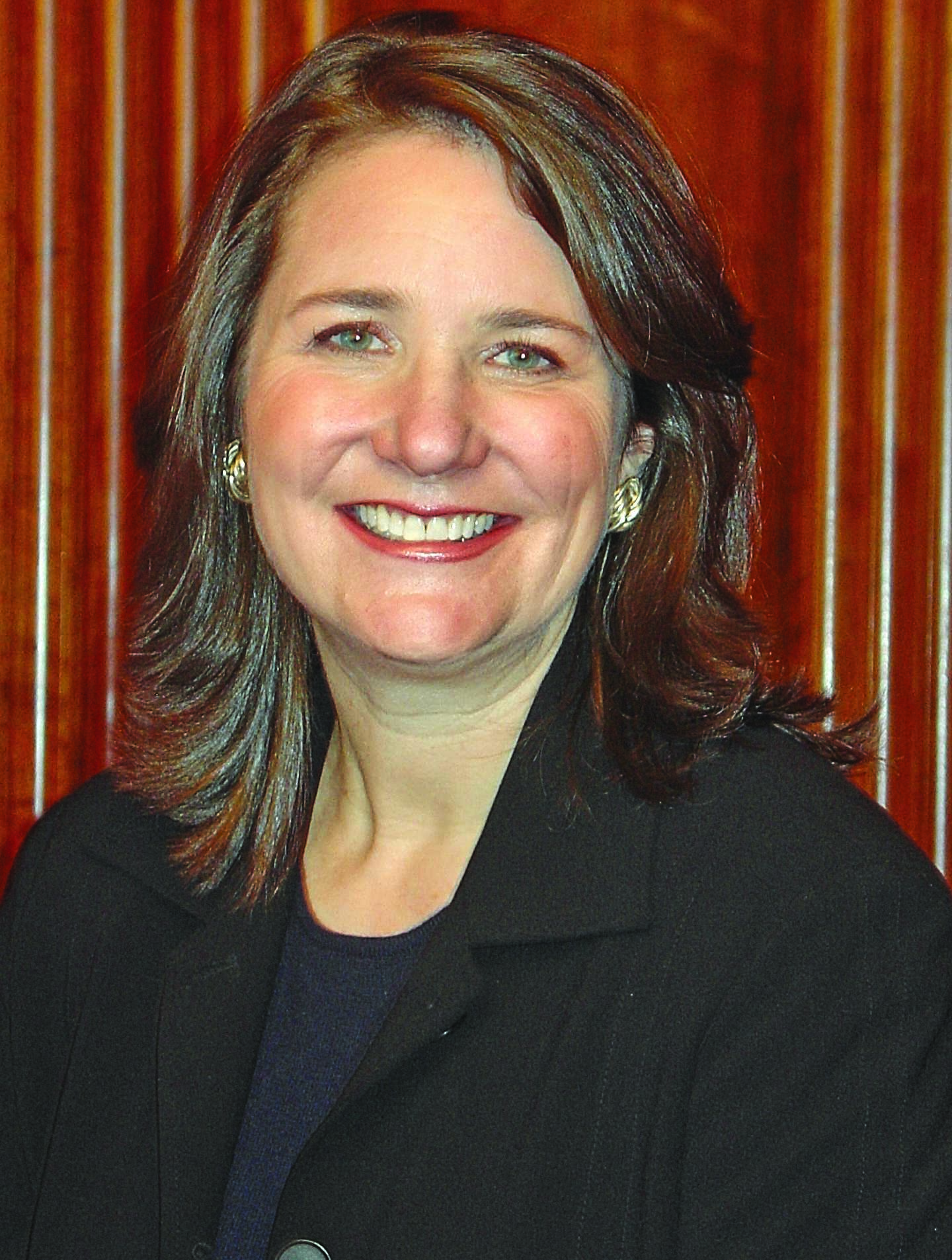
by Mark Smiley | Jul 24, 2017 | Editorials
 Denver District Attorney Beth McCann was sworn into office a little more than six months ago, but already appears to have lost the trust of her predecessor Mitch Morrissey, the rank and file of the Denver Police, and much of the public at large.
Denver District Attorney Beth McCann was sworn into office a little more than six months ago, but already appears to have lost the trust of her predecessor Mitch Morrissey, the rank and file of the Denver Police, and much of the public at large.
Her handling of the Colorado Open Records Act (CORA) scandal involving Police Chief Robert White and Deputy Chief Matt Murray as well as the inmate killing at the Denver Jail has brought into serious question whether she remains intellectually capable of handling the difficult job as head law enforcement officer in the City and County of Denver. McCann gave interviews to the media in both cases, but the interviews raised even more questions than they answered.
The Denver Police had issued a press release accusing Angiella Arnot of sexual assault (along with a now former Denver Police Officer), but she was never charged. Longtime Denver DA Mitch Morrissey sent a letter to Police Chief White highly critical of Deputy DA Matt Maury’s “rush to judgment” in the arrest of an “innocent woman.” Chief White responded to the DA in a two sentence letter declaring he would “look at the totality of the situation and . . . ensure that the appropriate action is taken.”
When the Denver police union asked for a copy of the letter pursuant to CORA it was told that the police department was “unaware of any … electronic or written exchanges responsive to your request.” It was a lie and White and Maury knew it according to the one honest person in the sordid affair, Mary Dulacki, Department of Safety Records Coordinator.
It was an open and shut case of a criminal violation of CORA by the two highest cops in Denver. McCann had promised the voters during her campaign that she would strongly pursue cases of police misconduct. What she meant, of course, was that she would go after the cop on the beat, but vigorously ignore the most blatant criminal conduct on the part of the top echelon bosses. This has always been the modus operandi of the office of the Denver District Attorney. In the early 1960s 47 Denver police officers were charged as part of a massive burglary ring, but not a single higher up in the police department was brought before the bar of justice even though it was impossible that such a huge criminal enterprise could be going on without the implicit knowledge and consent of members of the top brass.
The blatant CORA criminal violation last year was too much for former DA Mitch Morrissey who said he would have definitely brought charges against Deputy Chief Murray and would have strongly considered charging Chief White. The head of the Denver police union, Nick Rogers, has publicly excoriated McCann indicating that the rank and file were losing all respect for her. McCann made matters worse by going on air with Channel 7’s Tony Kovaleski. She embarrassed herself by endlessly and unsuccessfully trying to hide the fact that her chief deputy had strongly recommended bringing charges.
Following that PR disaster McCann was caught red-handed as part of a scheme to hide the fact that an illegal immigrant, Ricardo Lopez Vera, had killed another inmate in the Denver jail. The Denver Sheriff’s Department had hidden him from ICE as part of the city’s widely acknowledged sanctuary city policy. McCann again compounded her error by doing another media interview this time on the The Craig Silverman Show on 710 KNUS where she was eviscerated by Silverman, a former Denver Chief Deputy DA.
The fact that at age 69 she no longer has the mental acuity she once had was dramatically demonstrated when she used the “f” word on air with Silverman. There are only seven words clearly banned by the FCC for which a radio station can be fined for airing and the “f” word is one of them. After over 40 years in public life, DA McCann is well aware of that limitation, but she is apparently unable to control herself.
Some individuals are mentally sharp well into their 90s while others begin to show serious mental deterioration by their late 60s. Obviously, McCann fits into the latter group.
The sad part is she is just beginning her term as DA. Denver has a woeful habit of endlessly re-electing incumbents no matter their infirmities. It can be expected that McCann, at age 80, will still be the Denver DA at the start of the year 2029. The DA’s office will, of course, be a wreck and utterly rudderless. It is said that people get the government they deserve, but even Denver’s severest critics would say we don’t deserve a District Attorney’s office like the one we now have.
— Editorial Board

by Mark Smiley | Jun 23, 2017 | General Featured
DPS Board Votes Unanimously In Reynolds’ Favor
by Ruthy Wexler
 In an extraordinary reversal of fortune, The Denver Public Schools Board of Education at its meeting on June 19, 2017, chose existing Greenlee Elementary School Principal Sheldon Reynolds to lead the restart of Greenlee in 2018-19. He will keep his staff for this next school year and for the upcoming restart, which will be under a new name, Center for Talent Development at Greenlee (CTD).
In an extraordinary reversal of fortune, The Denver Public Schools Board of Education at its meeting on June 19, 2017, chose existing Greenlee Elementary School Principal Sheldon Reynolds to lead the restart of Greenlee in 2018-19. He will keep his staff for this next school year and for the upcoming restart, which will be under a new name, Center for Talent Development at Greenlee (CTD).
If Reynolds hadn’t been chosen to lead the restart, he would still be acting principal of Greenlee in the 2017-18 school year, but it would have been a year filled with sadness, teacher unrest, staff seeking employment at other schools — and his own disappointment at not being able to continue the work he had begun.
The Board had designated Greenlee as “persistently low-performing,” along with another elementary Denver school in December 2016 (still another elementary school, Gilpin Montessori, was closed for good due to failure of test scores to improve sufficiently. Under the recently adopted School Performance Compact (SPC) subjective factors are eliminated and a purported objective mandate based on primarily test scores control. See Greenlee Elementary On The Chopping Block, front page Glendale Cherry Creek Chronicle, March 2017.
The outcry from the parents, students, teachers and others involved with the school, which is located at 1150 Lipan Street, was immediate. In the first 18 months of Reynolds’ tenure at Greenlee morale and test scores had soared but simply just not enough under the criteria set out in the SPC. Greenlee faces a plethora of challenges including the fact that it is a school with a majority of low income students for whom English is a second language.
The competition for the restart was opened to any school providers who wanted to submit a “high quality” plan, according to DPS’s requirements.
Reynolds made a presentation along with a half dozen other applicants at the School Board meeting on May 11. After the June 19 Board vote the only real change in Greenlee Elementary will be its name,
which will now be Center for Talent and Development at Greenlee and that is just fine with the community surrounding the school which had come to embrace Reynolds and his reform efforts.
Reading teacher Lisa Friedman whooped with joy at the news. “Now we can continue the work we started. I can’t wait.”
“It’s been an interesting journey, hasn’t it?” a smiling Anne Rowe, President of the Denver School Board, said to Reynolds at a June 12 Board meeting, a week before the Board’s final vote. (This June 12 meeting’s purpose was for a newly instituted Community Review Board to recommend a school to lead Greenlee’s restart; they unanimously chose Reynolds’ plan and Reynolds’ leadership.)
“Yes,” Reynolds agreed — his tone not quite as lighthearted as Rowe’s.
Changing A School
“When I first stepped into Greenlee, I knew nothing about the SPC,” said Reynolds. “Honestly, if I had known, I never would have taken the job.”
In 2015 Reynolds was offered two Denver schools and chose Greenlee. He welcomed the opportunity to turn an unpromising school around. The way he’d do it was with a “talent development model,” a concept he’d studied while working on his doctorate in educational leadership. The North Carolina school he built entirely on that model in 2010 not only won awards, it changed the area’s demographics, when families moved nearby to enroll their kids.
Reynolds had just laid the groundwork for change at Greenlee — knowing it could take up to five years to completely change a school — when he had to shift gears for the restart plan.
No Room For Error
The restart competition got kicked off with DPS’s Call for New Quality Schools (The Call), which invited “school developers” to submit “high quality designs” for the two schools to be restarted as well as proposals for new schools. Reynolds knew his basic design; he’d given it a new name (CTD). The hard part would be having his vision shine through while addressing every detailed requirement listed in The Call.
Comfortable with tapping the strengths of those around him, Reynolds met continually with staff, who, he said, “pushed me to define what makes our school different.”
Detecting a “woe is me, the District is out to get us” mentality, Reynolds coached his teachers toward this attitude: “We control what happens.”
“I told them, ‘People might not see you, but I know you guys are great teachers.’ See, I already had that turnaround mentality, you’ve got to be better than a teacher at another school, better than another principal … There’s no room for error when you’re turning a school around.”
Working together produced unity. At the Special Board of Education meeting on May 11, when applicants formally presented their plans, a dozen teachers surrounded Reynolds, all wearing resolute expressions and bright blue Greenlee sweatshirts.
At the beginning of that meeting, Greenlee parents pleaded to keep their principal. One young mother said tremulously, “My grandmother, who just passed away, worked at Greenlee for 26 years. She saw principals come and go. When Mr. Reynolds arrived, she knew he was the one we needed…”
Only one school emerged to challenge Reynolds for Greenlee’s restart: Wyoming-based Poder Academy. CEO Marco Martinez said he needed to take the school over because Greenlee, “despite infusions of help, has been drastically underperforming,” assuring the Board that with strict behavioral expectations, he would “turn the school and community around.”
The Work We Started
Martinez’s words — and DPS’s description of Greenlee as “persistently low-performing” — seemed to belong to a different world than the one inhabited by Greenlee teachers and parents.
When his turn arrived, Reynolds tied the two worlds together. “One thing I want to spell out clearly: if you don’t know us, it’s easy to say our students are broken, our teachers are broken, our community is broken. But once you work in our community, you see how strong it is …”
Asked by the Board what his new plan would change, Reynolds was hard put to give a specific answer. He’d added elements, notably a “birth to 5th” program to include very young children. But the basic concepts he ran the school on would remain.
On June 12, Reynolds spoke frankly to the Board, allowing that the restart process had pushed him to articulate “what makes our school unique. That’s where I wanted to end up … it’s just not how I wanted to get here.”
Having to draw so hard on his and staff’s resources drove him to be “an architect” for deeply held beliefs. “In the process, I bonded with my community. I put my name on it.”
And while others wish summer vacation could last longer, the staff, students and parents at Greenlee can’t wait for the new school year to begin.

by Mark Smiley | Jun 23, 2017 | Glendale City News
by Kurt Woock
Writer for and on behalf of the City of Glendale
 At 1,727 square feet, the new video screen installed at Infinity Park earlier this summer covers an area the size of a three bedroom house. It’s more than twice the size of the previous video board. But the gains can be measured in more ways than sheer size.
At 1,727 square feet, the new video screen installed at Infinity Park earlier this summer covers an area the size of a three bedroom house. It’s more than twice the size of the previous video board. But the gains can be measured in more ways than sheer size.
“The city planned to replace the old video screen this year,” said Linda Cassaday, Glendale’s deputy city manager. The screen had reached the end of its projected lifetime. Screen technology has not only made significant advancements in the near decade that has elapsed since Infinity Park opened, but also the old technology is truly obsolete: Cassaday said it was becoming difficult, if not impossible, to find replacement parts.
Cassaday said the new screen, and the company that made it, needed to fit a few requirements. First, the screen needed to be versatile enough to accommodate the many needs at Infinity Park, which include showing live video from rugby matches, displaying statistics and advertisements, and broadcasting movies during Monday Movie Madness (the last of which wasn’t even on the city’s radar when the first screen was installed). Second, in order to conserve time and money, the video screen needed to be able to use the old screen’s existing platform. Third, the company providing the screen needed to be able to have a proven track record of being able to respond quickly to problems when they arise. After interviewing a few companies, Cassaday said the top choice was clearly Daktronics.
Daktronics is a South Dakota-based company that has been making electronic scoreboards, programmable display systems, and large screen video displays since 1968. Both the company headquarters and the manufacturing facility are in Brookings, South Dakota, which was an important factor for Cassaday. “When you have an issue, you want to reach out locally, especially when it comes to technica l problems,” she said. At one point, the video screen had an issue the day before a tournament. Needing a fix as soon as possible, the crew at Infinity Park was at the stadium at 1 a.m. in order to connect with the provider, which is located halfway around the world. With parts only one state away, addressing pressing issues quickly becomes much easier.
l problems,” she said. At one point, the video screen had an issue the day before a tournament. Needing a fix as soon as possible, the crew at Infinity Park was at the stadium at 1 a.m. in order to connect with the provider, which is located halfway around the world. With parts only one state away, addressing pressing issues quickly becomes much easier.
Chances are you’ve already seen a Daktronics product. Mile High Stadium, Coors Field, and Pepsi Center all use Daktronics video displays. In fact, nearly every major professional sports team in the country uses a Daktronics video screen in their home stadium, as do many college stadiums. Although this will be the first Daktronics installation at a rugby stadium in the U.S., Daktronics is no stranger to Rugby as Twickenham in London and the Adelaide Oval in Australia both use Daktronics screens.
Each board at Daktronics is custom made for the customer. The new screen at Infinity Park is the largest size that the current support system can handle. It measures 24 feet by 53 feet (the old board was 20 feet by 33 feet) and uses 13HD LED technology, the best currently available. “When you go to any sporting event and look up at the big screen, a lot of fans expect it to be as clear as their screen at home,” said Eric Cain, regional sales rep for Daktronics. “In the past, it was a bit more grainy. In the last seven years, we were able to get that clarity. That’s the goal: To make a live event realm be as good as or better than your living room.” In addition to the main video board, a new ribbon display will stretch 250 feet along the east end of the stadium.
All that new space will enhance the in-game experience for fans and will give advertisers more value for their sponsorship dollars. Instead of a static sign with a company logo printed on it, like the ones that surrounded the old video screen, the new video screen will be able to have moving logos, will be able to incorporate sponsors into in-game video, and can allow more sponsors to be featured in more interesting ways. “We can increase sponsorship opportunities because of it, recouping our cost that much more quickly,” Cassaday said. Companies can, for example, sponsor halftime or each time the home team scores. Cain said other stadiums have used the ribbon board to display statistics, freeing the main scoreboard for larger video and to engage with fans by displaying live social media feeds and conducting in-game fan polls.
The relationship between Daktronics and Infinity Park will not end when the installation is complete. Daktronics also provides software packages that display information on the screen and has in-state, full-time technicians, removing the need for Infinity Park to find contractors who are familiar enough with their video screen. Cain, who grew up in and lives in Colorado, is looking forward to a long tenure at Infinity Park. “I can’t express how pumped Daktronics is to be part of the first rugby stadium in the U.S.”

by Mark Smiley | Jun 23, 2017 | Travel
 by Ruthy Wexler
by Ruthy Wexler
The U.S. Constitution is mentioned a lot these days — as a talking point. TV pundits warn that it’s being destroyed; politicians blithely assure us that a recent action they took is “in the Constitution.” If only we could go someplace and learn from scratch: what is this document that began our country?
Turns out there is such a place: the National Constitution Center.
Of course, it’s in Philadelphia — but your journey there will be shorter and less arduous than the ones delegates undertook in 1787: jouncing in carriages or on horseback, they traveled rough roads for days. Once in Philly, they sat in a sweltering hot room and argued. Why couldn’t small states have as many representatives as big ones? What sort of leader should they have, if any?
Finally they emerged with a blueprint for a free nation.
Agreed, their country wasn’t wholly free. Some delegates owned slaves, women had few rights. And no, our current society isn’t perfect. But before you withdraw into cynicism, go visit the Constitution Center. You’ll see how this complex document allowed the United States to change over the years — and how those long-ago men planned a distribution of power so skillfully, our democratic experiment is still alive.
Freedom Rising
Best to start a few blocks away where the Constitution was written: Independence Hall, which looks exactly the way it did 230 years ago. A guide points out the dais where George Washington sat and watched each day’s proceedings without ever saying a word. (Everyone knew how much he cared.)
Approaching the Constitution Center, a shining white structure set way back on a wide lawn, I’m stirred to wonder: how did the Founding Fathers come to design a country around the idea of freedom?
The introductory multimedia presentation, Freedom Rising, explains. Colonists knew they needed a central government for safety — but feared giving any foothold to tyranny, the thing they hated most. So their representatives, framing the new government’s basis, analyzed each sentence and statue: would it allow liberty to survive?
“Can liberty survive?” the narrator concludes dramatically. “It depends on you … and you … and you.”
Rich History
The Story of We the People, the ring-shaped series of exhibits on the second floor, constitutes the heart of the museum. One of the first displays is a shelf of Enlightenment books that delegates referenced while deliberating. We learn that Thomas Jefferson shipped volumes from France so James Madison could study ancient federations. Whatever their limitations, the framers were not, as some have claimed, interested only in protecting their property.
With timelines etched above, explanations at eye level and details crammed in every corner, history comes alive. Exhibits, arranged in chronological order, show how the Constitution was challenged and survived. There are exhibits for each of the original seven articles, for the Bill of Rights (the first 10 amendments) and the other amendments as well. Because they’re connected to constitutional issues, we learn about slavery, freedom of speech, labor unions and capital punishment.
Forward March Of Justice
It’s not just gazing into glass cases. You can pull levers in a voting booth, take the presidential oath at a podium, watch a video of new U.S. citizens. Winding my way around the rotunda, I see, at intervals, the same interactive screen: Can You Vote? Early on, the screen asks, “Are you white?” I press “yes” and am allowed to continue. But when I say no to the next question, “Are you a man?” a big red DENIED lets me go no further.
Even though I knew it was coming, I feel the unfairness.
Subsequent screens show how fairness got slowly instituted: nonwhites able to vote after the Civil War), then women (19th Amendment), then 18-year-olds (26th amendment. The framers, men of their time, were wise enough to know that times change; to ensure liberty for unknown future generations, they put the amendment process in place.
Exhibits show how the Constitution stretched for justice to march forward. Sometimes, as demonstrated in the Dred Scott exhibit, freedom took a backward step, when judges were slaves to beliefs of their time and could only interpret the Constitution narrowly.
It’s a document to be proud of, but not complacent about. More deeply than ever before, I’m seeing that if liberty is to survive, it is truly up to “you … and you …” and me.
The last exhibit is delightful Signers Hall, where 42 life-size figures — the 39 who signed the Constitution and the three who refused — stand frozen in thoughtful poses. I see how tall Washington was, and that Alexander Hamilton, of recent Broadway fame, was quite short!
As everyone snaps selfies with the signers, a docent offers personal tidbits; e.g., Rufus King of Massachusetts borrowed books from the library but never returned them; Washington went fishing during the August recess and caught some perch. And when the Constitution came back from being engrossed on parchment, it was, Washington said, “little short of a miracle.”
After all, this was the first time that a people had written down rules to start a nation off from scratch.
Historic Philadelphia
The National Constitution Center welcomes visitors seven days a week (except major holidays). Children enter free; tickets (adults, $14.50; seniors, $13) are half p rice if you go first to the Visitors Center, get tickets to Independence Hall and present those passes. Another advantage to stopping at the Visitors Center: the roving Once Upon A Nation storytellers who will spin a true yarn while you rest on a bench.
rice if you go first to the Visitors Center, get tickets to Independence Hall and present those passes. Another advantage to stopping at the Visitors Center: the roving Once Upon A Nation storytellers who will spin a true yarn while you rest on a bench.
The Constitution Center frequently hosts presentations, “timely constitutional conversations from all sides of the debate” and your trip could possibly be planned around one of these enlightening town halls. To find out more, visit constitutioncenter.org or call 215-409-6600. To see more pictures, visit www.glendalecherrycreek.com.

by Mark Smiley | Jun 23, 2017 | Editorials
In Alexandre Dumas’ beloved historical novel The Three Musketeers, a young man named d’Artagnan travels to the capitol and joins the Three Musketeers of the Guard (Athos, Porthos and Aramis). Together they fight off the minions of Cardinal Richelieu, the evil minister to the weak King Louis XIII.

 Today in Denver a modern parallel may be occurring. A young man, Jolon Clark, was elected to Denver City Council in 2015. Joining him on the Council were the Three Musketeers of the People — Wayne New, Paul Kashmann and Rafael Espinoza. The Three Musketeers were the only City Councilmembers elected without developer money and thus free to fight the good fight against the developers’ powerful corruption of Denver.
Today in Denver a modern parallel may be occurring. A young man, Jolon Clark, was elected to Denver City Council in 2015. Joining him on the Council were the Three Musketeers of the People — Wayne New, Paul Kashmann and Rafael Espinoza. The Three Musketeers were the only City Councilmembers elected without developer money and thus free to fight the good fight against the developers’ powerful corruption of Denver.
Slowly Clark began to learn of the perfidy of many of the other nine members and their lack of ethics or honesty. The “beefy, bloated and ethically challenged” director of the Orwellian named “Denver Community Planning Development Director” Brad Buchanan makes a perfect evil Cardinal Richelieu to the weak head of state, Mayor Michael Hancock.
The first real battle that Jolon Clark and the Three Musketeers have fought together was against the small lot exemption being used by Buchanan for his real estate developer friends to build micro-housing cells free from any parking requirements. This would have made finding on-street parking in some neighborhoods difficult, if not impossible, during certain times.
The residents fighting this proposal had gone to duplicitous Council President (and mayor-in-waiting) Albus Brooks who pretended to be their friend but intended to destroy their cause with a phony moratorium. In Dumas’ novel Albus Brooks would be the treacherous Richelieu spy Milady de Winter. Brooks had set up a crooked developer controlled “Task Force” whose basic purpose was to basically give developers everything they wanted and the neighborhoods nothing.
Our heroes led by Clark took up the citizens’ cause in the nick of time. Incredibly the city staff headed by Buchanan and the phony Task Force of Brooks called for no parking restrictions on the 3,000 plus small lots across the city. If the City had adopted the same, it would have made on-street parking in neighborhood after neighborhood throughout Denver a nightmare.
This is not by accident. Buchanan and his Planning Department literally want to make parking a nightmare so that all Denver residents, other than the very wealthy, are forced to walk, ride bikes or take public transportation in Denver with a rare Uber trip allowed. The old, the infirm, the crippled are to be sacrificed on the altar of the young and healthy millennials and of course the high density real estate developers who are the true enemy of Denver neighborhoods.
With rapiers drawn, Clark, New, Kashmann and Espinoza went to work. They convinced three other councilmembers to support a compromise whereby the parking requirement exemption would only apply for housing or offices in the first story, or the first two floors if within a quarter mile of a frequent bus line or within one-half mile of a light rail station. Apparently well-connected developers can still go to the City Council for full exemptions provided notice is given to the affected neighborhoods before a vote.
The vote was 7-6 in favor of the Musketeers and Denver neighborhood on-street parking was at least partially saved. With other amendments added, the final vote was 9-2, an abject humiliation for Albus Brooks, his Task Force and Planning Director Brad Buchanan. Only Brooks and developer owned Mary Beth Susman voted against the final version. If neighborhood groups are looking for a test recall case, Brooks and Susman would certainly be the names on the top of the list.
Of course, Denver and its neighborhoods are in continued danger. It can only be hoped that the alliance formed among d’Artagnan and the Three Musketeers continues strong to beat back the endless efforts of Buchanan, the weak Mayor, and the corrupt members of the Denver Council to destroy what makes Denver a great city, its neighborhoods.
As Dumas’s Musketeers would shout: “Un pour tous, tous pour un.!” — “All for one, and one for all!”
— Editorial Board

by Mark Smiley | Jun 9, 2017 | Travel
by Diana DeGette
Don’t hold me to it, but there’s a good chance that June in Washington, DC won’t be the wild roller-coaster ride that May was.
It’s no exaggeration to say that nearly every day last month brought stunning news that raised concerns about the state of our democracy, starting at the top. There was one shocking revelation after another involving Russian officials, President Donald J. Trump’s actions, the firing of FBI director James Comey, alleged conversations between Comey and President Trump, and other matters.
But as of this writing in late May, things have started to settle down — in part thanks to the appointment of a special counsel to oversee the FBI’s Russia investigation, which I had called for in a letter to Deputy Attorney General Rod Rosenstein earlier in the month while at home in Colorado.
I was especially pleased that Rosenstein tapped former FBI Director Robert Mueller, whom I know to be a man of integrity, professionalism and absolute dedication to justice.
Given the complexities of the situation and what is sure to be a thorough investigation under Mueller’s leadership, we can expect that it will be a long time before his work produces conclusions that can be shared with the public.
So maybe now we can get dispense with dramatic distractions for a while and get back to what Congress should do: pass legislation that improves life for Americans and helps make our country more secure.
If the President keeps to the promises he made in January, this would include major tax reform and an initiative to fix America’s crumbling infrastructure. But his one-page tax plan outline from late April hasn’t yet been translated to legislation, and an infrastructure bill is evidently even further down the road, since there’s been no sign of one yet.
Meantime, the House Republican leadership has forged ahead on its unilateral effort to dismantle the Affordable Care Act, jamming through a TrumpCare bill without waiting for an assessment of its costs and effects from the non-partisan Congressional Budget Office. The CBO reported in the last week of May that if this bill becomes law, it will ration care and put insurance companies back in charge. Twenty-three million people will lose their coverage within 10 years while the cost for millions others will go up — including those covered through employer plans. The onus is now on the Senate to prevent this damage.
We also should be deep into the process of preparing a budget for Fiscal Year 2018, which starts on October 1. President Trump’s budget blueprint in March, which slashed spending for important domestic and foreign policy priorities in favor of dramatically boosting the military budget, was greeted as a non-starter by congressional Republicans and Democrats alike.
The appropriations process only begins in earnest when the President presents an actual, detailed budget request to Congress, which he finally did on May 23. If enacted, this heartless and short-sighted budget proposal would cripple important domestic and international programs to create needless tax breaks for the wealthy. Republicans and Democrats alike spoke up immediately to protest it.
The delays, chaos and dysfunction that have characterized the Trump administration to date have not only affected the work of Congress. They have also undermined Americans’ confidence about where we’re headed as a country and how it affects our standing in the world.
With respect to the matters involving Russia and President Trump’s campaign and administration, the coming weeks and months will likely bring more revealing investigative reporting, along with rampant rumors, misdirection and misinformation. A truly independent, impartial Special Counsel will follow the cold, hard facts wherever they lead. And the Justice Department can determine whether there has been a violation of federal law in a way that no other approach to these issues can.
But that doesn’t rule out taking other paths to get at the truth. I have long supported the formation of an independent commission to investigate Russian interference in the 2016 election, including any possible collusion with the Trump campaign, and to ensure that such interference never happens again.
I first called for that commission in December when the intelligence community made clear that Russia had meddled in the election. That’s why I support, H.R. 356, the Protecting Our Democracy Act, which would establish such a commission. This bill has been ignored by the House Republican leadership, along with other substantive legislation intended to hold the President accountable.
An independent commission would involve experts from outside the government, who would not only seek out the facts, but also suggest solutions. The 9/11 Commission was one such effort, and its recommendations led to changes that helped make the United States safer.
Diana DeGette represents Colorado’s First District to the U.S. Congress. She serves as Chief Deputy Whip and is a senior member of the House Energy and Commerce Committee.

 Denver District Attorney Beth McCann was sworn into office a little more than six months ago, but already appears to have lost the trust of her predecessor Mitch Morrissey, the rank and file of the Denver Police, and much of the public at large.
Denver District Attorney Beth McCann was sworn into office a little more than six months ago, but already appears to have lost the trust of her predecessor Mitch Morrissey, the rank and file of the Denver Police, and much of the public at large.











